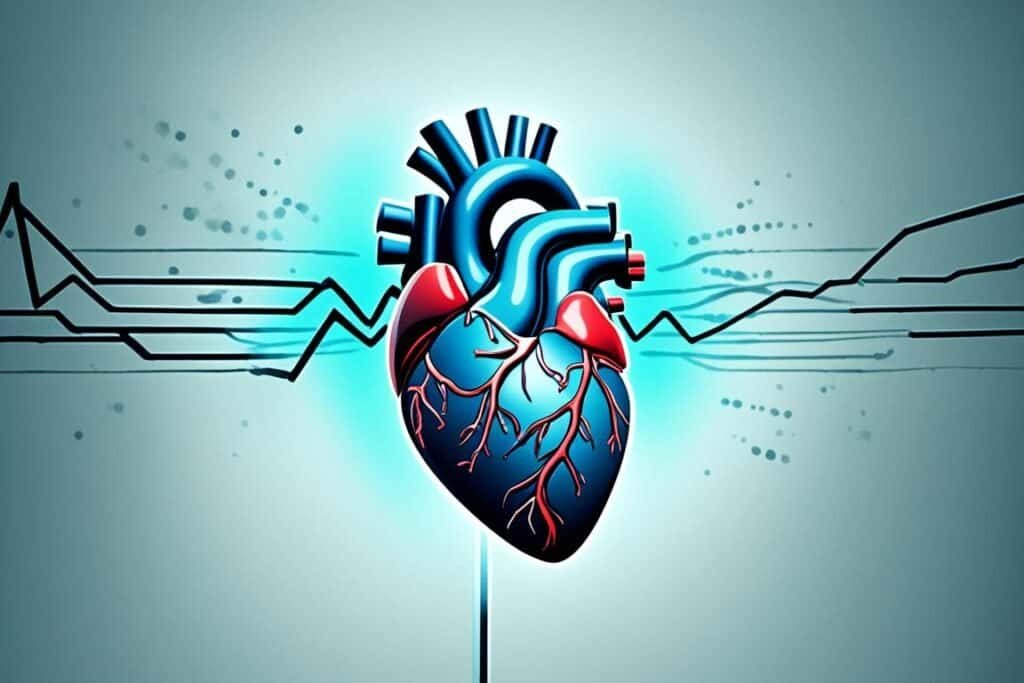Welcome to our article on silent heart attacks and their connection to future heart attack risk. A silent heart attack is a heart attack that occurs without symptoms or with unrecognized symptoms. It is a lack of blood flow to the heart, often resulting from blocked arteries, that occurs without pain. While silent heart attacks account for around 170,000 of the estimated 805,000 annual heart attacks, they are often overlooked due to their lack of noticeable symptoms.
People who have had a silent heart attack have the same long-term survival rate as those who have had ordinary heart attacks. However, they may be at risk of other complications such as heart failure and stroke. This makes it crucial to understand the risk factors, symptoms, diagnosis, and treatment options associated with silent heart attacks.
Recognizing the signs of a silent heart attack is vital for early detection, as individuals may dismiss symptoms that occur as simple fatigue, a strained muscle, or indigestion. Common symptoms can include fatigue, left arm pain or numbness, soreness in the chest or upper back, and an aching sensation in the jaw, arms, or upper back. If you experience any of these symptoms, it is important to seek medical attention immediately.
Diagnosis of a silent heart attack can be made through various tests such as electrocardiograms and blood tests. Once diagnosed, treatment may include medications such as aspirin and statins, as well as lifestyle changes such as regular exercise, a healthy diet, and smoking cessation. Taking proactive steps such as monitoring blood pressure and cholesterol levels, informing your doctor about any unusual symptoms, and adopting a heart-healthy lifestyle can improve your outlook and reduce the risk of future heart attacks.
Remember, silent heart attacks can have long-term consequences, and it is essential to prioritize your cardiovascular health. Regular check-ups, early detection, and prevention strategies can make a significant difference in reducing future heart attack risks. Stay informed, take action, and protect your heart!
Key Takeaways:
- Silent heart attacks occur without symptoms or with unrecognized symptoms.
- They can lead to complications such as heart failure and stroke.
- Risk factors for a silent heart attack are similar to those for a recognized heart attack.
- Recognize the symptoms and seek immediate medical attention.
- Diagnosis involves tests like electrocardiograms and blood tests.
What is a Silent Heart Attack?
A silent heart attack is a heart attack that occurs without symptoms or with unrecognized symptoms. It is a lack of blood flow to the heart, often resulting from blocked arteries, that occurs without pain. Unlike a typical heart attack, a person may not know they have had a silent heart attack and may not seek medical attention.
Symptoms of a silent heart attack can be easily dismissed as simple fatigue, a strained muscle, or indigestion. It is important for individuals to be aware of the signs and symptoms of a silent heart attack and seek medical attention if they experience any unusual symptoms.
However, since there is no pain, a person may only learn they have had a heart attack if they undergo testing for other symptoms. Common tests used to diagnose a silent heart attack include electrocardiograms and blood tests.
| Symptoms of a Silent Heart Attack | Tests for Diagnosing a Silent Heart Attack |
|---|---|
|
|

Risk Factors and Symptoms of a Silent Heart Attack
A silent heart attack can occur without any noticeable symptoms or with symptoms that are easily dismissed or attributed to other causes. It is important to be aware of the risk factors and symptoms associated with a silent heart attack to ensure early detection and timely medical intervention.
Risk Factors:
- Age: Advanced age increases the likelihood of experiencing a silent heart attack.
- Diabetes: Individuals with diabetes have an increased risk of developing heart disease, which can lead to a silent heart attack.
- Family History: Having a family history of heart disease or previous silent heart attacks can increase the risk.
- Heart Disease: Pre-existing heart conditions, such as coronary artery disease, significantly raise the risk of silent heart attacks.
- High Blood Pressure: Uncontrolled high blood pressure puts additional strain on the heart, increasing the likelihood of a silent heart attack.
- High Cholesterol: Elevated levels of cholesterol can contribute to the formation of plaque in the arteries, leading to blocked blood flow and silent heart attacks.
- High Stress: Chronic stress and anxiety can have detrimental effects on cardiovascular health and contribute to the risk of silent heart attacks.
- Lack of Exercise: Sedentary lifestyles and a lack of regular physical activity increase the chances of developing heart disease and experiencing silent heart attacks.
- Obesity: Excess weight puts strain on the heart and is associated with various risk factors for heart disease and silent heart attacks.
- Poor Diet: A diet high in saturated fats, cholesterol, and sodium can contribute to the development of heart disease and increase the risk of silent heart attacks.
Symptoms:
While a silent heart attack may not cause the typical chest pain associated with a traditional heart attack, there are still symptoms that individuals should be aware of:
- Fatigue: Unexplained and persistent fatigue or a feeling of extreme tiredness can be a symptom of a silent heart attack.
- Arm Pain or Numbness: Pain, discomfort, or numbness in the left arm, shoulder, or hand can indicate a silent heart attack.
- Chest Pain or Soreness: Some individuals may experience mild discomfort or soreness in the chest or upper back during a silent heart attack.
- Jaw Pain: Unexplained pain or aching sensation in the jaw, as well as the arms or upper back, could be a symptom of a silent heart attack.
It is important to note that these symptoms may be easily dismissed or attributed to other causes, resulting in a delayed diagnosis. If you experience any of these symptoms, it is crucial to seek immediate medical attention to minimize the risk of significant heart damage.
Diagnosis and Treatment of Silent Heart Attacks
Diagnosing a silent heart attack involves various tests to determine if a person has experienced a heart attack and assess any damage to the heart. These tests typically include:
- Electrocardiogram (ECG): An ECG measures the electrical activity of the heart and can identify abnormal rhythms or patterns that may indicate a silent heart attack.
- Blood tests: Blood tests can detect certain enzymes and proteins that are released into the bloodstream during a heart attack, providing further evidence of a silent heart attack.
If a silent heart attack is diagnosed, treatment options may include a combination of medications and lifestyle changes:
- Medications: Medications such as aspirin, statins, beta-blockers, and blood pressure-lowering medications may be prescribed to manage the underlying conditions contributing to the heart attack and reduce the risk of future heart attacks.
- Lifestyle changes: Adopting a healthier lifestyle is crucial in managing silent heart attacks. This may involve regular exercise, following a nutritious diet, quitting smoking, and managing stress effectively.
Following the guidance of your healthcare provider and taking proactive steps to improve heart health can significantly reduce the risk of future heart attacks and promote overall well-being.

Outlook and Prevention for Silent Heart Attacks
After experiencing a silent heart attack, it’s important to understand the outlook and take proactive steps to prevent future complications. While the risk of another heart attack, heart failure, stroke, and sudden death remains elevated, there are lifestyle changes you can make to improve your outlook and reduce the risk.
Lifestyle Changes:
- Regularly monitor your blood pressure and cholesterol levels to keep them within healthy ranges.
- Engage in regular exercise to strengthen your heart and improve overall cardiovascular health.
- Inform your doctor about any unusual symptoms you experience, as early detection is key.
- Avoid smoking and secondhand smoke, as smoking is a significant risk factor for heart attacks.
- Adopt a balanced diet that is rich in fruits, vegetables, whole grains, lean proteins, and healthy fats.
By incorporating these lifestyle changes into your daily routine, you can significantly reduce the likelihood of future heart attacks and improve your overall well-being. Remember, prevention is key in minimizing the danger and complications associated with silent heart attacks.
Preventing Future Heart Attacks:
Preventing future heart attacks requires a comprehensive approach that goes beyond lifestyle changes. It is crucial to manage underlying risk factors and take advantage of available medical interventions. Work closely with your healthcare provider to develop a personalized prevention plan that may include:
- Medications: Your doctor may prescribe aspirin, statins, beta-blockers, or other medications to manage your heart attack risk.
- Regular check-ups: Schedule regular visits with your doctor to monitor your cardiovascular health and make necessary adjustments to your treatment plan.
- Stress management: Incorporate stress-reducing activities such as meditation, yoga, or hobbies into your daily routine.
- Support network: Surround yourself with a strong support system of friends and family who can help you stay motivated and accountable to your prevention plan.
Remember that silent heart attacks can have significant implications for your long-term health. Being proactive and taking the necessary steps to prevent future heart attacks is crucial in maintaining a healthy heart and preventing potentially life-threatening complications.
| Complication | Risk |
|---|---|
| Another heart attack | Increased |
| Heart failure | Increased |
| Stroke | Increased |
| Sudden death | Increased |
Note: A silent heart attack can have serious consequences, but by taking proactive measures, you can reduce the risk of future complications and improve your overall health and well-being.
Conclusion
Silent heart attacks, also known as heart attacks without symptoms or with unrecognized symptoms, can have serious consequences such as heart failure and stroke. Although individuals who have experienced a silent heart attack have the same long-term survival rate as those who have had traditional heart attacks, they still face increased risks of future heart attacks, heart failure, stroke, and sudden death.
Early detection and prevention are crucial for minimizing the potential complications of silent heart attacks. Recognizing the signs and symptoms, seeking medical attention, and receiving appropriate diagnosis and treatment are key steps in this process. It is important to be vigilant for common symptoms such as fatigue, left arm pain or numbness, soreness in the chest or upper back, and an aching sensation in the jaw, arms, or upper back.
To improve heart health and reduce the risk of future heart attacks, it is essential to prioritize cardiovascular health. This can be achieved through lifestyle changes such as regular exercise, maintaining a healthy diet, and avoiding smoking. Additionally, monitoring blood pressure and cholesterol levels regularly, as well as managing other risk factors such as diabetes and stress, are important in preventing and detecting silent heart attacks.

